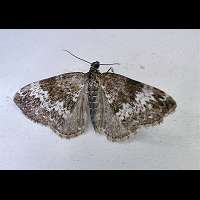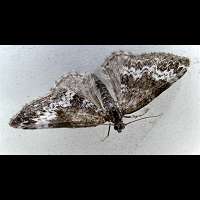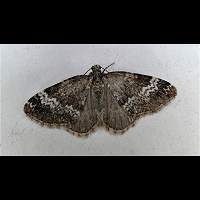Small Rivulet (Perizoma alchemillata)
This very small Geometer looks rather like a Pyralid Moth. The markings on the front wings however are typical for a Geometer. If in doubt, always take a look at the way the moth is holding its antennae while in rest. Pyralids always put their antennae on top of their body. Usually they are pointing backwards, laying on the wings near the body. Geometers always put their wings under their bodies while at rest. Sometimes they are kept in front of them, but never on top. The Small Rivulet has dark grey wings with a white band in the middle and numerous white lines and smears elsewhere. It looks a lot like the Rivulet, but is smaller. On the hindwing the Rivulet has a conspicuous broad white band, the Small Rivulet a hardly visible, narrow and greyly speckled band. The white band on the front wing has an idention in both species. This idention usually consists of one single dent in the Rivulet and of two dents close together in the Small Rivulet. This characteristic however isn't always clearly visible. The wingspan of the Small Rivulet varies from 22 to 24 mm.
The larvae appear from July and are light green. On both sides runs a broad, pinkish to purplish very broad line and their head is black. From the end of August to the beginning of October they leave the foodplant to go underground to pupate and overwinter. They are some 10 to 13 mm in length. The foodplant is the Hemp-nettel, of which they eat the flowers and seeds. The abundant presence of the Small Rivulet in areas where the foodplant doesn't grow, has lead to the conclusion that there possibly are other foodplants as well. It is not sure which plants these are, even though the Woundwort is often mentioned.
For a single-brooded species the Small Rivulet is on the wing for a long time: from June to mid August. They'll fly from dusk onwards and are attracted to light, but in very unpredictable numbers. Moderately common all over Britain, including the Hebrides and Orkney. In other parts of Europe common, fairly common, or a local species.
This very small Geometer looks rather like a Pyralid Moth. The markings on the front wings however are typical for a Geometer. If in doubt, always take a look at the way the moth is holding its antennae while in rest. Pyralids always put their antennae on top of their body. Usually they are pointing backwards, laying on the wings near the body. Geometers always put their wings under their bodies while at rest. Sometimes they are kept in front of them, but never on top. The Small Rivulet has dark grey wings with a white band in the middle and numerous white lines and smears elsewhere. It looks a lot like the Rivulet, but is smaller. On the hindwing the Rivulet has a conspicuous broad white band, the Small Rivulet a hardly visible, narrow and greyly speckled band. The white band on the front wing has an idention in both species. This idention usually consists of one single dent in the Rivulet and of two dents close together in the Small Rivulet. This characteristic however isn't always clearly visible. The wingspan of the Small Rivulet varies from 22 to 24 mm.
The larvae appear from July and are light green. On both sides runs a broad, pinkish to purplish very broad line and their head is black. From the end of August to the beginning of October they leave the foodplant to go underground to pupate and overwinter. They are some 10 to 13 mm in length. The foodplant is the Hemp-nettel, of which they eat the flowers and seeds. The abundant presence of the Small Rivulet in areas where the foodplant doesn't grow, has lead to the conclusion that there possibly are other foodplants as well. It is not sure which plants these are, even though the Woundwort is often mentioned.
For a single-brooded species the Small Rivulet is on the wing for a long time: from June to mid August. They'll fly from dusk onwards and are attracted to light, but in very unpredictable numbers. Moderately common all over Britain, including the Hebrides and Orkney. In other parts of Europe common, fairly common, or a local species.






